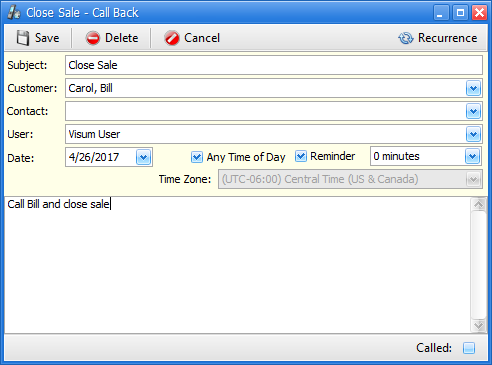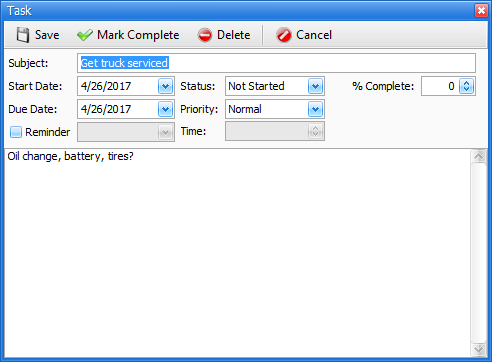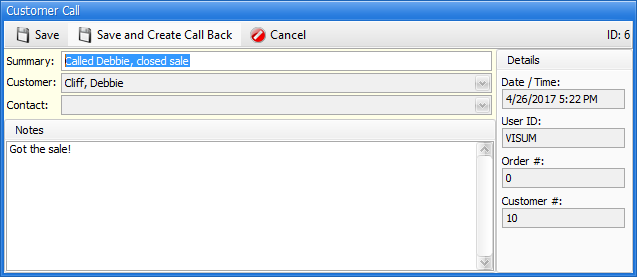F-2 from the Main Menu
The CRM dashboard is broken up into six sections:
1.Callbacks
2.Appointments
3.Tasks
4.Salesperson quota
5.New customers
6.Call notes

Callbacks
The callbacks section of the dashboard shows a list of all the callbacks that are scheduled for today. If you double-click on the callbacks heading, a new screen will open showing you an expanded view of the callbacks screen.
If you right click anywhere in the callback section, you can start a new callback or a new recurring callback (repeating callback). When you add a new callback, the following screen will appear:

Subject - Enter a subject for this callback. this subject, along with the customer, will show on the main dashboard screen. Keeping the subject brief and on point will make help the appearance of the call back section of the dashboard.
Customer - Select a customer for the call back.
Contact - Select a contact from the list of available contacts for the customer for this callback.
User - This field will default to your own user, but can be changed as needed. You can assign callbacks to different users if your FocalPoint security allows you to do so.
Date - Set the date that the callback should be made. Today's date will default in this field. You can use the "Any Time of Day" checkbox to specify whether this callback should have been at a certain time of day or not.
Reminder Information - If you would like a reminder screen to pop up for this callback, check the Reminder checkbox and set the number of minutes prior to the call back that you should receive your reminder.
Callback notes - Use the notes section of this callback screen to describe what this callback is for.
Appointments
This section of the dashboard allows you to record both appointments and events. Events will show in the area directly below the date. Appointments will show in the hourly time slots in the appointments section.
You may right-click anywhere in these areas to perform the following actions:
•Create a new appointment
•Create a new all day event
•Create a new recurring appointment
•Create a new recurring all day event
If you double-click on the appointments heading, a larger enhanced view of your appointments for a week at a time will display.
Tasks
To add a task to the dashboard, right click on the tasks heading. You will be able to create a task with a subject line, start date, due date, status, priority, and percent complete. You can also set reminders for your tasks. Finally, there is a notes section for your tasks.

A task that has either a start date or a due date on the day that the dashboard is representing will show on the dashboard.
You can also assign tasks to other users if you have permissions to do so, and Mark tasks complete.
If you double-click on the task heading, and expanded task screen will open.
New Customers
The new customers section of the dashboard will show you all the new customers that you added today. You can double-click on the new customers heading for an expanded view of customers.
Salesperson Quota
The salesperson quote a section of the dashboard is a series of graphs that show quotas and actual revenue and activity information. The quotas are set in the salesperson file, 6-3 from the main menu. Graphs are available for the following metrics:
•Rental revenue
•New rental sales
•Use rental sales
•New merchandise sales
•Used merchandise sales
•Deliveries
•Charge customers
•Cash customers
•Call notes
On the dashboard screen, the salesperson quota graphs will rotate between all of these measurements. If you double-click on the salesperson quota heading, the following screen will appear:

Call Notes
Call notes are used to record the communications you had with your customers today, and also can be used to generate new callbacks. The dashboard will show you a list of call notes that you have entered today. You can right click on the call notes heading to add a new callback, or double-click on the call notes heading to expand the call notes section of the screen.
When adding a new customer call, you can use the summary field to summarize the call, and information. The notes section allow you to add details about the call. When you're finished, you can either save the call note, or save the call note and create a callback, which will invoke the callback screen.
